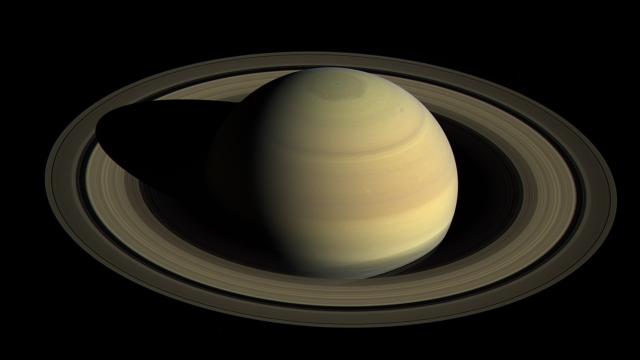A survey of Saturn’s outer reaches has resulted in the discovery of 20 new moons. With 82 known natural satellites, Saturn now boasts the most moons of any planet in the solar system, surpassing Jupiter’s 79 known moons.
It’s always special when astronomers spot new moons, but this latest discovery is extreme — 20 new moons confirmed all at once, as announced Tuesday by the International Astronomical Union’s Minor Planet Centre.
The team behind the discovery includes Scott Sheppard from the Carnegie Institution for Science, David Jewitt of UCLA, and Jan Kleyna from the University of Hawaii. The distant orbs were spotted with the Subaru telescope located on Hawaii’s Mauna Kea, according to a Carnegie press release.
As you might recall from last year, Sheppard was involved in the discovery of 12 additional moons around Jupiter, bring the Jovian giant’s total to 79. The new discovery brings Saturn’s total up from 62 to 82 — the most in the solar system.
“Finding new moons of the planets is hard because they are generally very faint and thus hard to track year to year in order to get reliable orbits for them,” Sheppard wrote in an email to Gizmodo. “I have been using some of the largest telescopes in the world to find the new moons and an updated computer algorithm to link the new discoveries year to year, allowing us to officially determine they are orbiting Saturn and thus are new moons of Saturn.”
When asked why it took so long to find these new moons, Sheppard said it’s because they’re so dim. Currently, astronomers are “only able to find moons that are a a few kilometres in size around Saturn because the planet is so far away,” he said. Sheppard and his colleagues suspect there are 100 moons around Saturn larger than 1.5 kilometres in size, “but future larger telescopes will be needed to find these smaller and thus fainter moons.”
Each of Saturn’s newly discovered moons measures between 3 and 4 kilometres in diameter, so yeah, they’re tiny. Of the 20 new moons, three are in prograde orbit (moving in the same direction as Saturn’s rotation) and 17 are in retrograde orbit (you guessed it, moving opposite Saturn’s rotation).
All of the new moons are relatively far from Saturn. Two of the prograde moons require around two years to make a complete orbit of the gas giant, while the remaining 18 moons require more than three years to make a single orbit (our Moon requires 27 days to make a complete orbit around Earth). The most extreme of these new moons, designated S5613a2 m, requires 1,413 days, or 5.3 years, to revolve around Saturn, making it the farthest known moon from the gas giant.
The new moons were slotted into three distinct categories depending on the angles at which they orbit around Saturn.
Two of the prograde moons were assigned to the Inuit group (shown in blue in the graphic above), the moons of which are named after Inuit mythology. The Inuit moons are likely remnants of a large moon or object that disintegrated into smaller fragments a long time ago.
The remaining prograde moon was placed in the Gallic group (shown in green), but it’s much farther out than previously known Gallic moons, so this designation may not stick, according to the Carnegie release. All 17 of the retrograde moons have similar inclinations to the Norse group (shown in red), so that’s where they’ve been placed. The Norse group, like the Inuit group, is believed to have originated from a much larger object that broke up into smaller pieces, likely from a collision.
Saturn is farther away from Earth than Jupiter is, so it’s tougher to find moons around Saturn. Seeing that Saturn “has more moons even though it is harder to find them, shows just how many moons Saturn has collected over time,” Sheppard told Gizmodo.
“Because these new moons are on inclined orbits far from Saturn itself, we believe these new moons were captured by Saturn just after the planet formation process. These moons are the remnants of the objects that helped form the planets, so by studying them, we are learning about what the planets formed from.”
Excitingly, a contest has been created for the public to choose names for the 20 moons. Sorry, but Saturn McSaturnFace won’t be allowed, as the names have to conform to their mythological groupings, along with other naming conventions.
Welcome, new moons! We look forward to learning more about you.
